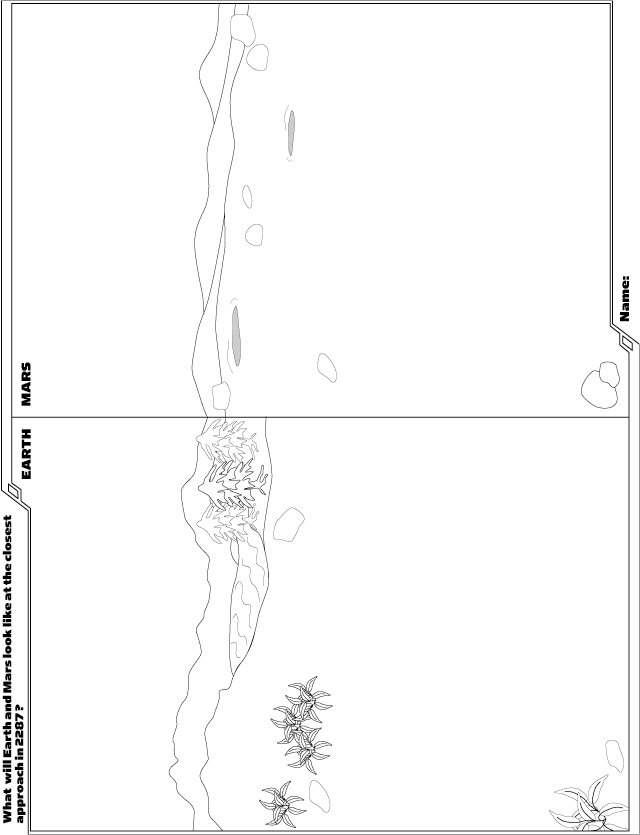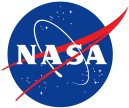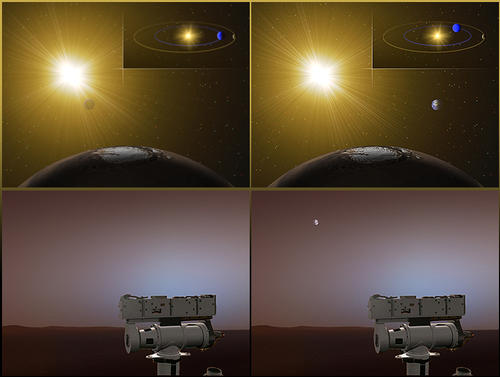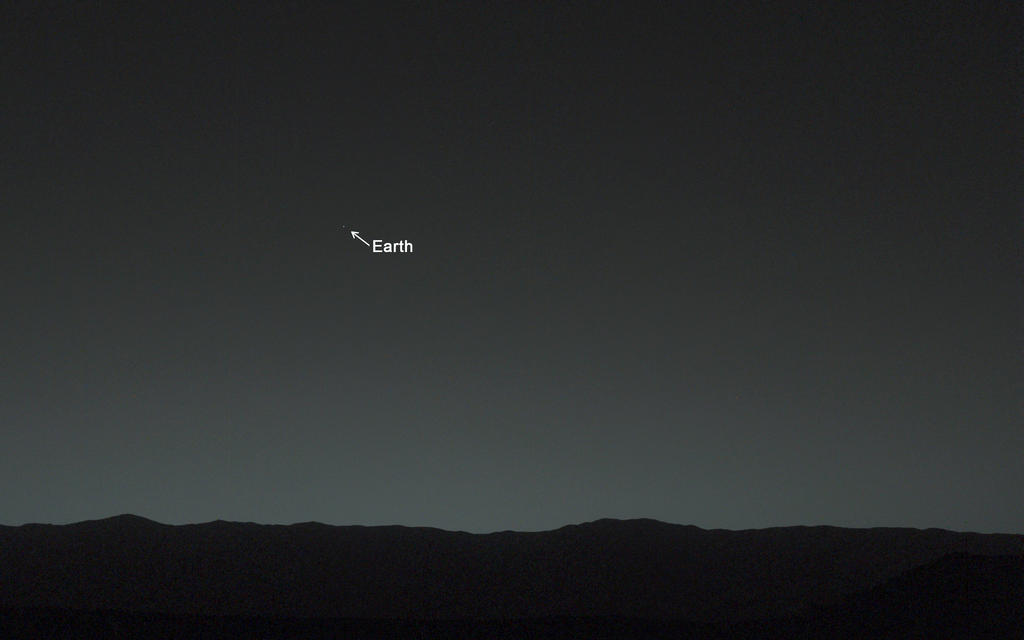Mars Close Approach
2005: Earthlings Will Get a Better View of Mars
The armies of ancient Rome, before going into battle, trained outside the city walls on a field named for Mars. Processions honoring victorious military commanders began on the "Campus Martius" and ended inside the city. Mars was the god of war. In the arms race of the Roman Empire, Mars was the celebrated winner.In the celestial race around the sun, however, Earth vanquishes Mars. Like a chariot racing around an oval track, Earth has been passing Mars every two years and two months since long before the rise and fall of Rome. Each time it does this, the two planets come closer than at any other time during their orbits. The next close encounter will occur at 8:19 p.m. Pacific Daylight Saving Time (11:19 p.m. Eastern Daylight Saving Time) Oct. 29, 2005. Blazing in the Eastern Sky Not all close encounters are equal. Some, like this one, are more spectacular than others because the distance between the two planets is always changing. "The orbits of the planets are ellipses," explains Moriba Jah at NASA's Jet Propulsion Laboratory, a navigator on the Mars Reconnaissance Orbiter, a mission now en route to the red planet. "They're not perfect circles. Gravitational effects from the sun and planets pull on the planets' orbits." During October and November of 2005, Mars will look like a blazing, orange-yellow star in the night sky. Usually, Mars is less obvious. The Red Planet comes close enough for such exceptional viewing only once or twice every 15 or 17 years, says geologist Tim Parker, a member of the Mars Exploration Rover science team. Not that Mars is close. Even during this encounter, 43 million miles (69 million kilometers) will separate Earth from Mars. That's an enormous distance. But it's only about one-third of the average 140 million miles (225 million kilometers) between the two. In 2003, Mars came closer to Earth than in the previous 60,000 years. That time, Mars was within 35 million miles (56 million kilometers) of Earth, within a day of reaching the closest point possible between the two planets.
"The very closest approach — the most that you can get — is when both planets are lined up at the time when Earth is at its farthest point from the sun and Mars is at its closest point," says Jah.
A Bright but Indecisive Warrior
Mars is already fairly conspicuous in the eastern sky. On a clear night, if you gaze at the red planet through a small telescope, you may be able to see light and dark markings on the surface or perhaps even the ice cap at the south pole. Of course, the bigger the telescope, the more detail you can see. Another similar encounter will not occur until 2018. Bathed in red, the color of blood, Mars reminded the ancients of an angry warrior whose behavior was erratic and unpredictable. As the planet moves across the night sky, it appears to make a hairpin turn and head in the opposite direction. A couple of months later, Mars makes another hairpin turn and resumes its earlier heading. This apparent change in direction is an optical illusion. It's like the impression you get if you look out the window of a train just as the train on the next track pulls ahead. For a moment, it seems like you're going backward. (What's the matter with this train, anyway? Oh, wait a minute. The slower train only looks like it's moving backward relative to the motion of the faster train.) After they've passed, the two vehicles look like they're moving in the same direction again. The same thing happens when Earth overtakes Mars. Other planets appear to change direction, too, but they're so much farther away that the effect is not as noticeable to the naked eye.A Little Help from the Sun
Even though Mars doesn't always come close enough for astronomers to get a good look at it when Earth speeds past, navigators have an opportunity to launch a spacecraft to Mars every 26 months. Unlike vehicles in science fiction movies, spaceships don't just take off in any direction. Escaping Earth's gravitational pull requires a tremendous amount of energy. Even then, without an extra push, a spacecraft would never reach the orbit of Mars.Bright 'Evening Star' Seen from Mars is Earth
This view of the twilight sky and Martian horizon taken by NASA's Curiosity Mars rover includes Earth as the brightest point of light in the night sky.
Credit: NASA/JPL-Caltech/MSSS/TAMLI
Credit: NASA/JPL-Caltech/MSSS/TAMLI
To get a spacecraft to Mars, navigators time the launch so the spacecraft reaches Mars when the red planet is on the opposite side of the sun from Earth. This way, they take advantage of solar gravity, which causes a spacecraft to "fall" toward the sun, traveling in an arc around it. This motion follows physical laws described by Isaac Newton and Johannes Kepler in the 17th century. "What you want to do is launch the spacecraft so it goes around the sun to meet Mars," says Jah. "We give it the least amount of energy possible and let the sun's gravity do as much as it can for us." As a result, like a warrior in a Roman chariot race, the spacecraft comes up on Mars from behind. But instead of sailing past, it slows down and lands.
2003: Mars Closest Approach
One summer evening in 1766, Benjamin Franklin may have noticed that Mars appeared unusually large. In 1845, Edgar Allan Poe might have looked up from his newly-published poem, "The Raven," to remark how the blood-red orb had grown. As recently as 1924, F. Scott Fitzgerald could have paused at a Jazz Age party to watch the bright, ruddy dot making its way across the sky.During each of these August nights, Mars and Earth were about 56 million km (less than 35 million miles) apart, among their closest approaches. But not since the Neanderthals lived have Earth and Mars been quite as close as on August 27, 2003 at 9:51 Universal Time (the time in Greenwich, England) -- 55,758,006 km (34,646,418 miles) from center to center. That was the nearest the two planets have been in almost 60,000 years! NASA and the European Space Agency have taken advantage of Mars' relative closeness to send spacecraft to the planet. Backyard astronomers are getting their best opportunity -- weather on Earth and Mars permitting -- for a good look at our celestial neighbor. That was the closest that the two planets will be until August 28, 2287! What will Earth be like when people marvel at the red planet nearly three centuries from now? And will there be people living on Mars by then, when an unusually close and large-looking Earth rises with the morning sun?
Kids! Imagine What Earth and Mars will be like next time they are so close together...in 2287! Download a coloring sheet here.
 Print a Download File (PDF, 770 KB) PDF landscape or GIF to show how you think Earth and Mars might look the next time they're so close.
Print a Download File (PDF, 770 KB) PDF landscape or GIF to show how you think Earth and Mars might look the next time they're so close.





